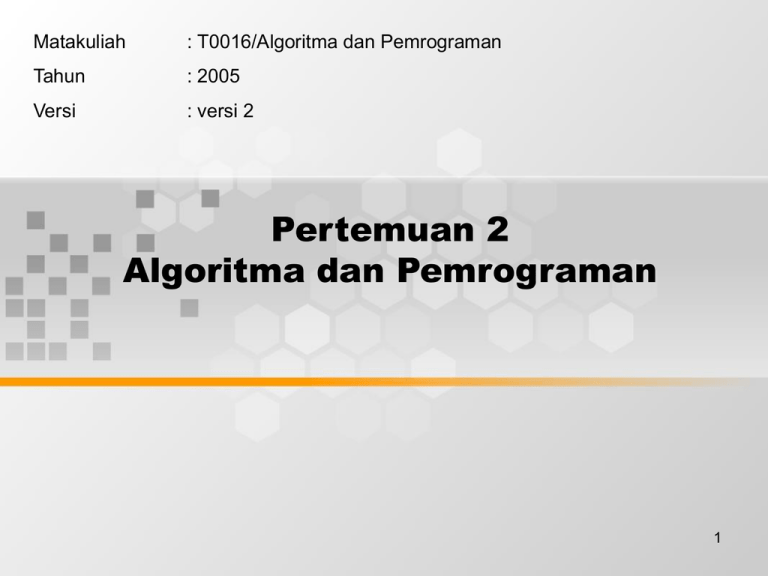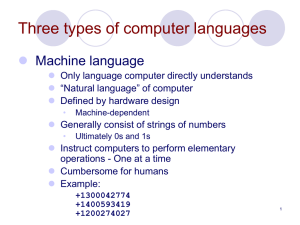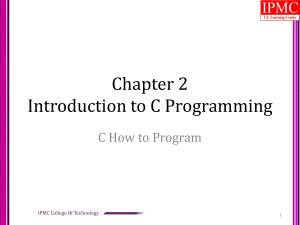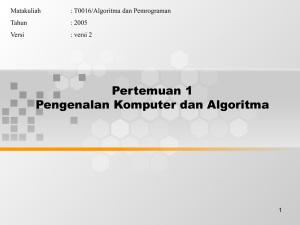
Matakuliah
: T0016/Algoritma dan Pemrograman
Tahun
: 2005
Versi
: versi 2
Pertemuan 2
Algoritma dan Pemrograman
1
Learning Outcomes
Pada akhir pertemuan ini, diharapkan
mahasiswa akan mampu :
• Menjelaskan hubungan antara masalahalgoritma – program
• Pengenalan bahasa C
2
Outline Materi
• Hubungan antara program dengan
algoritma
• Pengenalan bahasa C
3
Pemrograman
• Penulisan sejumlah kode tertentu untuk
menyelesaikan suatu problem berbasiskan
komputer
• Kode-kode tersebut dibuat sesuai
algoritma yang diinginkan
• Program yang dibuat harus sesuai dengan
format suatu bahasa yang digunakan
4
Hubungan masalah-algoritma-pemrograman
Permasalahan :
Menghitung jumlah N bilangan bulat >0
Solusi
Algoritma :
begin
set jumlah=0
set c=1
input N
implementasi
repeat until c>N
jumlah=jumlah +c
c=c+1
loop
Program Menggunakan compiler C/C++/VB dll
display jumlah
end
5
Chapter 2 - Introduction to C
Programming
Outline
2.1
2.2
2.3
2.4
2.5
2.6
Introduction
A Simple C Program: Printing a Line of Text
Another Simple C Program: Adding Two Integers
Memory Concepts
Arithmetic in C
Decision Making: Equality and Relational Operators
2000 Prentice Hall, Inc. All rights reserved.
6
7
2.1
Introduction
• C programming language
– Structured and disciplined approach to program design
• Structured programming
– Introduced in chapters 3 and 4
– Used throughout the remainder of the book
2000 Prentice Hall, Inc. All rights reserved.
8
2.2 A Simple C Program:
Printing a Line of Text
1
2
3
4
5
6
7
8
9
10
/* Fig. 2.1: fig02_01.c
A first program in C */
#include <stdio.h>
int main()
{
printf( "Welcome to C!\n" );
return 0;
}
Welcome to C!
• Comments
– Text surrounded by /* and */ is ignored by computer
– Used to describe program
• #include <stdio.h>
– Preprocessor directive
• Tells computer to load contents of a certain file
– <stdio.h> allows standard input/output operations
2000 Prentice Hall, Inc. All rights reserved.
9
2.2 A Simple C Program:
Printing a Line of Text
• int main()
– C++ programs contain one or more functions, exactly one of
which must be main
– Parenthesis used to indicate a function
– int means that main "returns" an integer value
– Braces ({ and }) indicate a block
• The bodies of all functions must be contained in braces
2000 Prentice Hall, Inc. All rights reserved.
10
2.2 A Simple C Program:
Printing a Line of Text
• printf( "Welcome to C!\n" );
– Instructs computer to perform an action
• Specifically, prints the string of characters within quotes (“ ”)
– Entire line called a statement
• All statements must end with a semicolon (;)
– Escape character (\)
• Indicates that printf should do something out of the ordinary
• \n is the newline character
2000 Prentice Hall, Inc. All rights reserved.
11
2.2 A Simple C Program:
Printing a Line of Text
• return 0;
– A way to exit a function
– return 0, in this case, means that the program terminated
normally
• Right brace }
– Indicates end of main has been reached
• Linker
– When a function is called, linker locates it in the library
– Inserts it into object program
– If function name is misspelled, the linker will produce an
error because it will not be able to find function in the
library
2000 Prentice Hall, Inc. All rights reserved.
1
/* Fig. 2.5: fig02_05.c
2
3
12
Outline
Addition program */
#include <stdio.h>
1. Initialize variables
4
5
int main()
6
{
7
2. Input
int integer1, integer2, sum;
/* declaration */
8
2.1 Sum
9
printf( "Enter first integer\n" );
/* prompt */
10
scanf( "%d", &integer1 );
/* read an integer */
11
printf( "Enter second integer\n" ); /* prompt */
12
scanf( "%d", &integer2 );
/* read an integer */
13
sum = integer1 + integer2;
/* assignment of sum */
14
printf( "Sum is %d\n", sum );
/* print sum */
3. Print
15
16
return 0;
/* indicate that program ended successfully */
17 }
Enter first integer
45
Enter second integer
72
Sum is 117
2000 Prentice Hall, Inc. All rights reserved.
Program Output
13
2.3
• As before
Another Simple C Program:
Adding Two Integers
– Comments, #include <stdio.h> and main
• int integer1, integer2, sum;
– Declaration of variables
• Variables: locations in memory where a value can be stored
– int means the variables can hold integers (-1, 3, 0, 47)
– Variable names (identifiers)
• integer1, integer2, sum
• Identifiers: consist of letters, digits (cannot begin with a digit)
and underscores( _ )
– Case sensitive
– Declarations appear before executable statements
• If an executable statement references and undeclared variable
it will produce a syntax (compiler) error
2000 Prentice Hall, Inc. All rights reserved.
14
2.3
Another Simple C Program:
Adding Two Integers
• scanf( "%d", &integer1 );
– Obtains a value from the user
• scanf uses standard input (usually keyboard)
– This scanf statement has two arguments
• %d - indicates data should be a decimal integer
• &integer1 - location in memory to store variable
• & is confusing in beginning – for now, just remember to
include it with the variable name in scanf statements
– When executing the program the user responds to the
scanf statement by typing in a number, then pressing the
enter (return) key
2000 Prentice Hall, Inc. All rights reserved.
15
2.3
Another Simple C Program:
Adding Two Integers
• = (assignment operator)
– Assigns a value to a variable
– Is a binary operator (has two operands)
sum = variable1 + variable2;
sum gets variable1 + variable2;
– Variable receiving value on left
• printf( "Sum is %d\n", sum );
– Similar to scanf
• %d means decimal integer will be printed
• sum specifies what integer will be printed
– Calculations can be performed inside printf statements
printf( "Sum is %d\n", integer1 + integer2 );
2000 Prentice Hall, Inc. All rights reserved.
16
2.4 Memory Concepts
• Variables
– Variable names correspond to locations in the computer's
memory
– Every variable has a name, a type, a size and a value
– Whenever a new value is placed into a variable (through
scanf, for example), it replaces (and destroys) the previous
value
– Reading variables from memory does not change them
• A visual representation
integer1
2000 Prentice Hall, Inc. All rights reserved.
45
Penutup
• Fungsi yang pertama kali dipanggil ialah
main()
• Setiap bahasa pemrograman mempunyai
format penulisan tersendiri
• Bahasa C mempunyai berbagai macam
operator.
17






